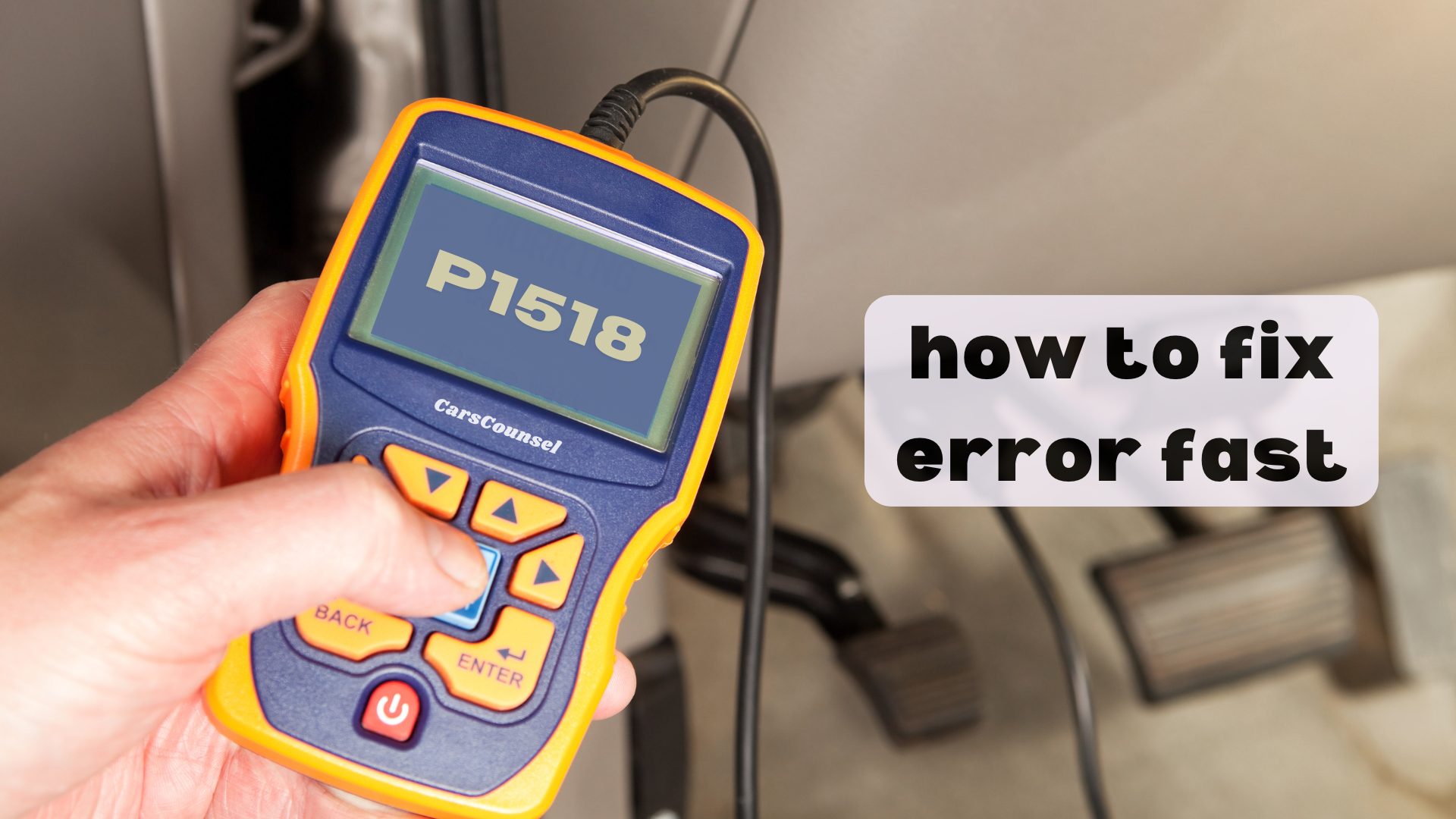Did you know that about 10% of vehicles face a P1518 code related to the intake manifold runner control (IMRC) system?
This error can make your car run poorly and turn on the check engine light, which is always annoying.
To fix this OBD2 error problem quickly, you need to check the IMRC actuator, throttle position sensor, and any wiring issues.
By understanding common causes and knowing the right steps, you can save time and avoid unnecessary repairs.
So, what exactly should you look for to solve this error effectively?

Quick Navigation
Key Takeaways
- Use an OBD-II scanner to confirm the P1518 code and pinpoint the problem.
- If needed, inspect and replace the IMRC actuator, solenoid, or throttle position sensor.
- Look for and fix any damaged or corroded wiring in the throttle system.
- Clean the throttle body and intake manifold to make sure air flows properly.
What Is the P1518 Code?
The P1518 code means there’s a problem with your car’s intake manifold runner control (IMRC) system, which can mess with how well your engine runs and how much fuel it uses.
The IMRC system helps regulate the airflow in the intake manifold to make the engine work more efficiently. When this system has issues, it can throw off the airflow, leading to less power and higher fuel consumption.
To figure out what’s wrong, start by using an OBD-II scanner to check for the P1518 code.
Then, look at the IMRC actuator and solenoid to see if they’re damaged. Also, check the wiring for any wear or corrosion.
Lastly, make sure there are no vacuum leaks affecting the IMRC system. Fixing these problems quickly will help get your car running smoothly again.
How P1518 Affects Your Car
How P1518 Affects Your Car
If your car shows a P1518 code, it means your engine isn’t running as well as it should. You’ll likely notice your car has less power and uses more gas. This code is related to problems with how air gets into the engine, which messes up the fuel mixture and makes the throttle less responsive. You might see your car idling rough or even stalling when you try to speed up. Plus, you’ll find yourself paying more at the pump because of increased fuel consumption.
To fully understand what’s wrong, use an OBD-II scanner to run engine diagnostics. This will help you find out exactly what’s causing the problem and check related parts.
| Symptom | Impact | Solution |
|---|---|---|
| Reduced Power | Slower acceleration | Inspect the IMRC system |
| Higher Fuel Use | More money spent on gas | Check for vacuum leaks |
| Erratic Idle | Unstable engine behavior | Test the throttle position sensor |
Common Causes of P1518
When dealing with a P1518 code, start by looking at common issues like bad IMRC parts, wiring problems, vacuum leaks, dirty components, and software bugs.
First, check the IMRC actuator, but remember that wiring issues are often the real problem. Look for damaged or corroded wires.
Use a vacuum gauge to find leaks because they can mess up the IMRC and throttle.
Try cleaning dirty parts, like the throttle body, as they can cause issues.
Don’t forget to check for software bugs in the engine control module (ECM); updating the software might fix the problem.
Identifying Faulty Components
Start by using an OBD-II scanner to confirm the P1518 code, then check the IMRC actuator, solenoid, and throttle position sensor for any visible damage and proper voltage. Here’s how to do it step-by-step:
- IMRC Actuator: Look at the actuator for any signs of wear or damage. Use a multimeter to see if the voltage readings are correct.
- Solenoid: Check the solenoid connected to the IMRC system for any problems or debris that might be causing issues.
- Throttle Position Sensor: Make sure the throttle position sensor is in good condition and its voltage output matches the manufacturer’s specifications.
- Component Cleanliness: Ensure all components are clean and free of dirt and debris, which can affect their operation.
Checking Wiring Issues
Check the wiring connected to the IMRC and throttle control circuits for any signs of wear, disconnection, or rust.
Start by visually inspecting each wire. Look for any damaged insulation or exposed copper.
After that, use a multimeter to test the circuits. Make sure there’s a continuous connection in the wires going to the IMRC and throttle control circuits.
If you find a break in the connection, fix or replace the faulty wires. Ensure all connectors are securely attached and free from rust.
Clean any rusted terminals before reconnecting.
Finally, use the multimeter again to confirm a proper connection.
This step-by-step process helps ensure your wiring is in good shape and working, which can help resolve potential P1518 code issues.
Spotting Vacuum Leaks
How to Find Vacuum Leaks
To find vacuum leaks, use a handheld vacuum gauge to check for any problems in the vacuum system. Here’s how to do it:
- Hook Up the Gauge: Attach the vacuum gauge to a vacuum hose connected to the intake manifold.
- Start the Engine: Turn on the engine and let it idle, then look at the gauge.
- Check the Readings: A steady reading between 17-22 inHg means the system is good. If the reading is low or keeps changing, there might be a leak.
- Use Soapy Water: Spray soapy water on the vacuum hoses and connections. If you see bubbles, that’s where the leak is.
This method helps you find leaks accurately, so you can quickly fix problems with the IMRC and throttle performance.
Recognizing Symptoms of P1518
After fixing any vacuum leaks, you should watch for symptoms of the P1518 code to make sure the problem is completely resolved. Look for signs like the engine stalling or hesitating when you accelerate, as these are common indicators.
Pay attention to any decrease in power while driving and increased fuel consumption, which can signal poor throttle response. Erratic idle behavior when stopped is another clue. The check engine light will also come on.
These tips for troubleshooting P1518 are crucial for identifying the problem early. Regular maintenance of the IMRC actuator, like cleaning the intake manifold runners, can prevent these symptoms.
Recognizing these signs ensures you fully address the P1518 issue and keep your vehicle running at its best.
Diagnostic Steps for P1518
Start by connecting an OBD-II scanner to your car’s diagnostic port to confirm the P1518 code. Use these steps to troubleshoot effectively:
- Check Components: Look at the IMRC actuator, solenoid, and throttle position sensor for any damage. Use a multimeter to check if the voltage is right.
- Inspect Wiring: Look at the wires for any frays, breaks, or rust. Test for continuity to make sure the electrical flow is good.
- Visual Inspections: Check for vacuum leaks and any visible damage in the IMRC and throttle systems. This can help you spot physical problems.
- Check Other Codes: Look for any additional error codes that might give more details about the P1518 issue. This can help you find the main problem.
Fixing the P1518 Code
Start fixing the P1518 code by replacing any faulty IMRC actuator, solenoid, or throttle position sensor.
First, replace the IMRC actuator by disconnecting the battery, removing the faulty actuator, and installing the new one.
Next, clean the throttle body. Disconnect the air intake, spray throttle body cleaner on the throttle plate and body, and wipe away any residue.
Then, replace any broken solenoids or sensors by disconnecting the wires, removing the old part, and installing the new one.
Finally, reconnect the battery and clear the code using an OBD-II scanner.
This simple process addresses common causes of the P1518 code and helps get your engine running smoothly again.
Preventing Future P1518 Issues
Keeping up with regular maintenance can help you avoid future P1518 issues by ensuring that parts like the IMRC actuator and throttle body stay clean and work well. Following a simple maintenance routine can save you money on repairs and keep your engine running smoothly.
Here are four easy steps:
- Regular Checks: Look over the IMRC actuator, throttle body, and related wiring for any signs of wear or damage.
- Clean Parts: Occasionally clean the throttle body and intake manifold runners to get rid of any dirt or debris.
- Change Filters: Replace air and fuel filters regularly to keep contaminants out.
- Update Software: Keep the engine control module (ECM) software up to date to avoid any issues.
More OBD-II Codes
Frequently Asked Questions
Can Driving With a P1518 Code Damage the Engine Further?
Yes, driving with a P1518 code can harm the engine more. Ignoring warning signs like lower engine power and higher fuel use can cause serious problems. Fix the issue quickly to keep your engine in good shape.
Are There Specific Tools Needed to Diagnose the P1518 Code?
To figure out what’s causing the P1518 error code, you’ll need a few tools. An OBD-II scanner will help you read the code. A multimeter is useful for checking voltage, and you might also need some basic tools to look over the wiring and vacuum lines for any problems.
How Long Does It Typically Take to Fix a P1518 Code Issue?
Figuring out what’s causing the P1518 code usually takes 1-3 hours. Fixing it can take anywhere from 1-6 hours, depending on whether you’re swapping out parts, fixing wiring problems, or updating software. Make sure to set aside enough time to get it all done.
Can a P1518 Code Be Temporarily Reset Without Fixing the Underlying Problem?
Yes, you can temporarily reset the P1518 code with an OBD-II scanner, but this is only a short-term fix. Disconnecting the battery might also work for a little while, but it won’t solve the real problem.
Is the P1518 Code More Common in Certain Vehicle Makes or Models?
To answer the question, the P1518 code isn’t tied to specific makes or models. It’s commonly found in cars with electronic throttle control systems, and this includes various brands with similar ETC setups.
Conclusion
By following these steps, you’ll fix the P1518 code quickly and get your car running smoothly again.
Imagine driving without any problems, with better acceleration and perfect throttle response.
Don’t let a little code keep your car off the road—take action now!
Check, clean, replace, and secure those parts.
Clear the error code and enjoy a perfect test drive.
Your car will thank you, and you’ll feel like a pro!

